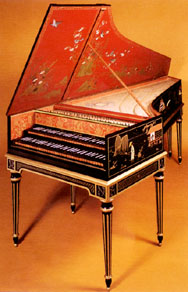
Harpsichord
Keyboard InstrumentHarpsichord (Italian cembalo; French clavecin), stringed keyboard instrument in which the strings are plucked to produce sound. It was developed in Europe in the 14th or 15th century and was widely used from the 16th to the early 19th century, when it was superseded by the piano.
In the 20th century the harpsichord was revived for performance of music of the 16th, 17th, and 18th centuries, as well as for new compositions. The incisive sound quality of the plucked metal strings adds clarity to melodic lines.
The harpsichord is particularly effective in performing contrapuntal music -- that is, music that consists of two or more melodies played at the same time, such as that of the German composer Johann Sebastian Bach.
The harpsichord usually has a wing-shaped body, or case, like a grand piano; however, its proportions are narrower and longer, and the case and its inner bracing are normally lighter. Harpsichords have also been built in other shapes. These include the virginal, or virginals, a small oblong instrument; the spinet, a small polygonal harpsichord; and the less common clavicytherium, an upright harpsichord. From the 16th to 19th century the terms spinet and virginal were often used interchangeably, and in England during that era any harpsichord was called a virginal.
Harpsichords of any shape have the same plucking mechanism. For each string a small piece of material, or plectrum, is set in a thin slip of wood, or "jack," which rests internally on the far end of the key. When the front of the key is depressed, the far end rises, and the plectrum plucks the string. The jack is pivoted so that, when the key returns to rest position, the plectrum slides by without striking the string. Since the volume and tone of the sound produced by the plucking mechanism remain constant regardless of the forcefulness of the keystroke, various methods have been developed to alter the harpsichord's sound. Many harpsichords have two strings for each key, with a row of jacks for each set of strings. Stops, or registers, allow the player to move unwanted sets of jacks slightly out of reach of the strings, thus making possible different volumes and combinations of tone colors. One set of strings may sound an octave above normal pitch. Some 18th-century German harpsichords had a set of strings sounding an octave below normal pitch. Harpsichords often have two keyboards, or manuals, which can usually be coupled or used separately, allowing further variations of tone color and volume. A typical two-manual harpsichord of the 18th century had strings at normal and octave-high pitch playable on the lower manual, strings at normal pitch controlled by the upper manual, and a coupling mechanism. The earliest school of harpsichord building developed in Italy in the 16th and 17th centuries. Italian harpsichords differed from others in that they normally were made of extremely thin wood and then placed in a stronger outer case of the same shape.
A second important school of building developed in the 16th and 17th centuries in Flanders, centered around the influential Ruckers family of builders. These schools gave way in the 18th century to distinctive styles of building that developed in France (the Blachet family), Germany (the Hass family), and England (Jacob Kirkman). Harpsichords of the different national schools varied in details of their proportions and construction, resulting in slight, although characteristic differences in tone color. In the 20th century, two broad approaches to harpsichord building emerged. The first utilized recent principles of construction, such as are found in present-day pianos. Stimulated by the Polish harpsichordist Wanda Landowska, this style was exemplified by the French piano firms of Pleyel and Erard. Their harpsichords relied on heavy strings under high tension in a heavily braced case.
Many 20th-century harpsichord works were written for such instruments. Other builders sought to relearn historical principles of proportion and construction in an effort to duplicate the sound of historical instruments. Stimulated by the German-English builder Arnold Dolmetsch and exemplified by Martin Skowroneck, a German, this school relied on light stringing in a highly resonant case. American builders in this style include William Hyman, Frank Hubbard, and William Dowd. American instrument maker John Challis employed a different, more modern approach to construction of the instrument. Though he based the decorative scheme of his designs on Dolmetsch's works, Challis experimented with new techniques and materials, such as metal and plastic, to produce harpsichords that were better adapted to the extreme climate changes in North America and maintained a rich tone quality.
Read more on Wikipedia.